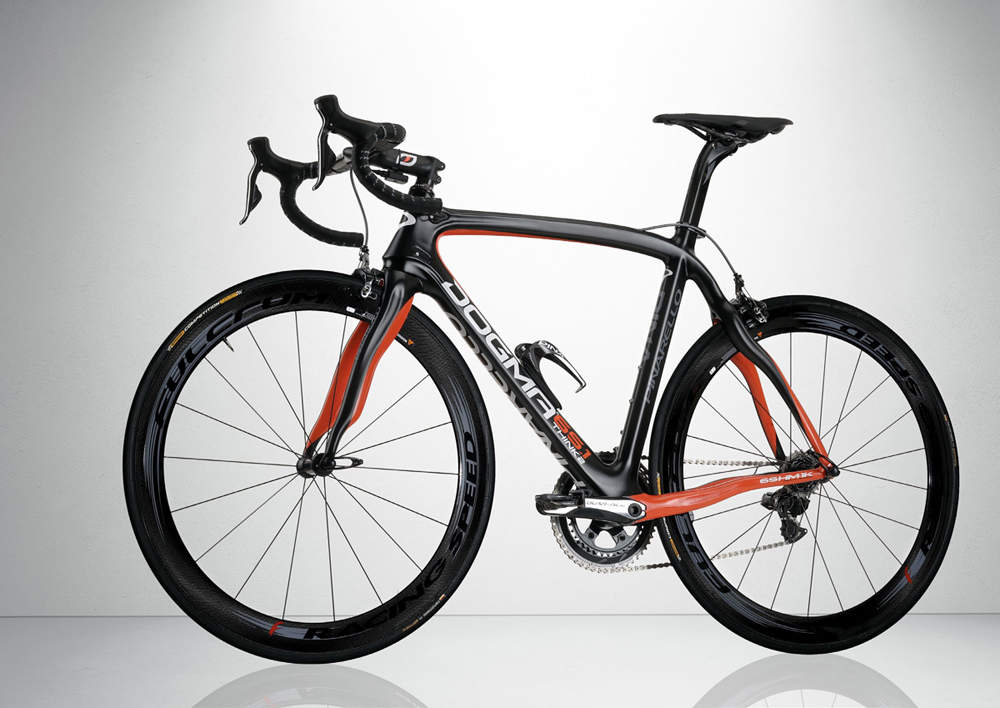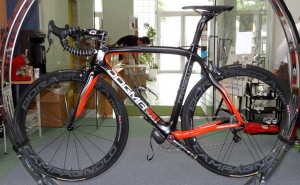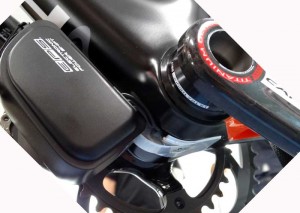
Pinarello’s new Dogma 65.1 Think2 flagship might have an awkwardly long name, but you forget all about it once you’re out on the open road.
Despite what’s always felt like hyperbole, it seems the generous praise that’s surrounded Sky’s curiously curvaceous team issue rig is all true. Few – if any – super bikes we’ve ridden can match the Pinarello’s new Dogma 65.1 Think2’s enormously improbable combination of ride quality, stiffness and handling.
Ride & handling: Magic in two-wheeled form
It’s difficult to describe the rolling contradiction that is the Pinarello’s new Dogma 65.1 Think2. On one hand, it’s remarkably smooth on rough pavement, and even flattens out nastier bumps while maintaining a firm, racy personality. However, while bikes this comfortable are often lacking in road feedback, the Dogma manages to send a steady stream of information through the handlebars and saddle, letting you know what’s going on at the tire contact patches.
For example, one of our typical test routes involves a long stretch of irritating chip seal that can really buzz your hands on an ultra-stiff machine. However, it was barely noticeable on the Dogma, which glided across as if it were going over fresh blacktop. Yet it still let us know the ground below was less than ideal – almost as though we were watching the whole thing from afar on HD.
Likewise, the bike is inordinately comfortable but exceedingly efficient, getting the job done not with a brutal rigidity but a stealthy, refined quickness that’s somewhat muted by the eerily capable vibration damping.
The Dogma’s impressive stiffness doesn’t so much slap you in the face as brush your cheek with a feather, and despite the subtler approach we still found ourselves flying on familiar short-but-steep pitches that require a quick burst of power. Moreover, that smoothness left us feeling fresher – and faster – at the end of longer rides, particularly ones involving lots of dirt roads.
The seat stay shape doesn’t seem to be purely for show – ride quality is exceptional
That rigidity isn’t isolated to the back end, either – the ultra-stout front helps define the Dogma’s precise and predictable handling. At moderate speeds, the bike feels unusually agile, with a turn-in that requires the utmost in attention – it doesn’t so much want to lean into turns as dive bomb them with aggression.
However, higher velocities mellow the Think2 a bit, with better – but not amazing – stability to help keep things calm when you’re in a full tuck or swooping through corners.
 Pinarello’s latest Dogma might be lighter than its predecessor, but it’s still a bit heavier than some other modern super bikes. Our accelerated test period didn’t allow time for our usual teardown procedures, but Pinarello claims 920g for a “raw” 54cm sample.
Pinarello’s latest Dogma might be lighter than its predecessor, but it’s still a bit heavier than some other modern super bikes. Our accelerated test period didn’t allow time for our usual teardown procedures, but Pinarello claims 920g for a “raw” 54cm sample.
Add in the bike’s typically generous coats of flashy paint plus the requisite derailleur hangers and seatpost collar and you’re easily over the 1kg (2.2lb) mark. In addition, the requisite fork comes in at about 370g, and the proprietary carbon fiber seatpost isn’t particularly svelte at nearly 200g.
Unless weight is your primary concern, though, it’s easy to forget there’s any additional mass beneath you. If that’s the price to be paid for such refinement, it seems like a worthwhile trade-off.
Frame: Asymmetry taken to the extreme
Asymmetrical chain stays and seat tubes are the norm these days, but Pinarello has taken the concept to extreme measures on the latest Dogma. Even the top tube is shifted slightly towards the driveside, to offset inherent differences in how forces are applied to the frame – or at least that’s what Pinarello says. If that’s the secret to the Think2’s uncanny ride quality then so be it, but it’s certainly a tough pill to swallow.
We were similarly skeptical about the frame’s characteristically wavy fork blades and seat stays. But in this case there seems to be some substance afoot. In theory, such abrupt changes in cross-sectional area and shape help attenuate certain vibrational frequencies, and it appears to work – exceptionally well, we might add – despite how odd the concept sounds on paper. In fact, Orbea has adopted a similar idea on its latest Orca stays.
Aside from the even more asymmetrical tube shaping relative to the previous Dogma 2, the new model’s biggest changes are a move to Torayca’s more advanced 65 ton carbon fiber material (hence the bike’s awkward name). It also has a newly convertible internal routing setup that accommodates conventional mechanical cables or electronic wires with a series of interchangeable, bolt-on ports scattered throughout the frame’s surface.
The relatively tidy solution to interchangeable electronic and mechanical routing
Other tech tidbits include the use of polystyrene internal molds, for better fiber compaction and a more consistent internal tube finish, plus nanotube-enhanced resins that supposedly boost impact strength. There’s also a tapered 1 1/8in to 1 1/2in head tube. Surprisingly, Pinarello outfits the Dogma 65.1 Think2 with a conventional Italian-threaded bottom bracket.
Equipment: Campagnolo electronic shifting and rock-solid alloy clinchers
US importer Gita Sporting Goods spared little expense on our loaner. The Pinarello’s new Dogma 65.1 Think2 was dressed in a Campagnolo Super Record EPS electronic group, Campagnolo Shamal Ultra medium-section aluminum wheels wrapped in Continental Force and Attack clincher tires, and a host of carbon fiber finishing kit from Pinarello house brand Most.
Total weight without pedals or bottle cages was 6.85kg (15.1lb). Swapping in a set of low-profile carbon tubulars could easily bring the figure closer to 6.5kg (14.3lb).
Our initial impressions of Campagnolo’s Super Record EPS electronic group haven’t changed since we first rode it back in November 2011. In short, it’s still flat-out amazing, with impeccable shift accuracy, smoothness and consistency but tactile feedback at the short-throw levers that so far is lacking in Shimano’s Di2 system.
Moreover, the drivetrain was whisper quiet, with nary a noticeable hum on rare occasions when our forward progress was perfectly matched by an encouraging tailwind.
As expected, braking performance was outstanding, with the mixed dual/single pivot calipers and generous machined aluminum brake track on the Shamal Ultra rims. Initial bite was aggressive without being overly grabby, modulation was smooth and predictable, and lever feel was communicative and firm, just as it should be.
Some readers might be disappointed to see aluminum clinchers included here, but any real-world disadvantage would be mostly imagined, aside from aerodynamic performance.
Overall stiffness with the meaty rims and fat bladed aluminum spokes was superb, both laterally and in torsion, lending to the chassis’s excellent handling and drivetrain efficiency. Moreover, the front- and rear-specific Attack and Force clinchers are impressively supple, offering excellent grip and ride quality.
A 2:1 lacing pattern on the rear wheel helps equalize spoke tension from left to right
Unfortunately, we weren’t quite as enamored with the Most bits on our test bike. While the integrated cockpit looks sleek, the overly shallow compact bend doesn’t provide much difference in body position between the hoods and the drops – not exactly ideal for a full-blown race rig.
Moreover, Most has conveniently provided bolt-on covers on the underside of the bar that conceal the cables and allow for fashionably bare tops, but the surface is too slippery for our liking in that state. Plus, the covers have annoyingly sharp edges that occasionally nicked our fingertips. We’d strongly advise wrapping the bars as usual here.
The Catopuma saddle was agreeable enough – it’s similar in feel to the Selle Italia SLR Flow in profile. But the proprietary carbon fiber seatpost’s twin-bolt head leaves much to be desired, as the forward bolt can only be accessed with an open-ended box wrench. Annoyingly, there’s no Allen-head fitting (or hole in the top of the mast) for access from below, nor can you reach a tool through a cutout saddle from above.
Finally, there’s the issue of the Dogma 65.1’s price tag. There’s simply no other way to put it – it’s astronomical. Suggested retail price for the frame, fork and headset is US$5,300 / £3,699. The complete build we tested costs a jaw-dropping US$12,500 / £9,500.
If you can afford it, what you get in return is an utterly extraterrestrial ride quality, enviable efficiency and an undeniably distinctive look. But no one will ever accuse the Pinarello Dogma 65.1 Think2 of being good value.
Summary =
Few – if any – super bikes we’ve ridden can match the Dogma 65.1 Think2’s enormously improbable combination of ride quality, stiffness and handling.
Ride & handling: Magic in two-wheeled form
Moreover, that smoothness left us feeling fresher – and faster – at the end of longer rides, particularly ones involving lots of dirt roads.
Source = bikeradar


